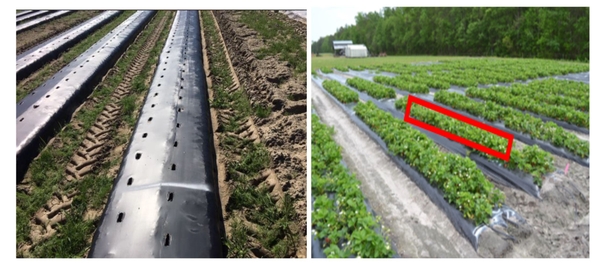Authors
Andres D. Sanabria-Velazquez1, Tika Adhikari1 and Frank Louws1,2
1Department of Entomology and Plant Pathology, North Carolina State University, 1575 Varsity Drive, VRB Module 6, Raleigh, NC 27695
E-mail: adsanabr@ncsu.edu ↲ and tbadhika@ncsu.edu ↲
2Department of Horticultural Science, North Carolina State University, 118 Kilgore Hall Raleigh, NC, 27695-7609.
E-mail: fjlouws@ncsu.edu ↲
Anaerobic Soil Disinfestation (ASD)
In the Southeast United States (USA), strawberries are grown as an annual crop. Several on-farm research studies have been conducted over the last 15 years to develop economically viable non-fumigant soil-borne disease management programs. Management systems that have been evaluated were to utilize compost, cover crops, crop rotations, organic amendments, biofumigation of soil with a mustard meal, and the use of anaerobic soil disinfestation (ASD) methods.
Researchers discovered ‘Anaerobic Soil Disinfestation (ASD)’, also known as ‘Biological Soil Disinfestation (BSD)’, a ‘game changer’ alternative for managing several soil-borne diseases, plant-parasitic nematodes, and weeds in vegetable and fruit crops. This technique consists of incorporating carbon sources followed by saturating the soil with water to induce anaerobic conditions. These soil conditions induce changes in the physicochemical and biological properties of the soil, favoring the rapid colonization of beneficial microbiomes and reducing pathogen populations. This technique is a very promising alternative, as it has been shown in previous works to have an efficacy comparable to chemical fumigants, with the advantage that it can be used in both organic and conventional systems.
The effectiveness of ASD mainly depends on the selection of carbon sources, rate of its application, and anaerobic period. Additionally, soil temperature and water holding are equally important. Carbon sources used to initiate ASD in different production systems include agricultural by-products such as ethanol, molasses, rice bran, mustard meal, wheat bran, compost, poultry litter, crucifer, and legume cover crops.
ASD procedure: 1-Soil preparation and amendment incorporation:
The soil is prepared in advance by the grower (disced, pre-plant fertilizer, pH adjusted). Beds are performed, and the carbon sources are placed on top of the pre-formed beds at high rates of approximately 9 tons per acre. Carbon sources are rototilled into the bed to ensure thorough mixing approximately 8 inches deep; then in one pass, the soil is pulled, drip tape laid down and the bed is covered with TIF (Figure 1).
Labile organic byproducts can be used as carbon sources for ASD. Some carbon sources effective for ASD include ethanol, molasses, rice bran, mustard meal, wheat bran, compost, poultry litter, crucifer, and legume cover crops. The seasonality of their availability increases the prices of these carbon sources, therefore this should be considered before choosing a carbon source. In general carbon sources that break down quickly and have a carbon to nitrogen ratio of 10:1 to 35:1 can be used for ASD.
2-Soil saturation and coverture with plastic mulch
To sature soil with water, a lay-flat tubing is rolled out and ½ inch non-perforated hosing is fed to each ASD bed to saturate the ASD beds by splicing into the buried drip tape and capping the ends of the ASD area. Saturation with water will depend on the soil type, therefore the time needed varies from 6 hours to 48 hs. Together with saturation with water, soil coverture with plastic mulch is necessary to prevent oxygen from entering soil as well as to limit the scape of gasses produced during ASD. Different types of plastic coverture can be used, but TIF is likely to reduce gasses exchange with the environment. Therefore, holes and plastic ripping should be avoided to achieve good anaerobic conditions (Figure 2).

Figure 2. Soil tarping with plastic mulch for anaerobic soil disinfestation treatment. Soil beds are saturated with water using drip tape. When the soil is completely saturated, it has a waterlogged and squishy appearance.
Photo credit: Tika Adhikari CC BY 4.0
3-Tarping period and post-treatment management
The tarping period varies from 3 weeks to 6 weeks depending on the carbon source, soil type, and temperature. Higher temperatures favor ASD since soil microbes break down the carbon sources faster. Temperatures higher than 86 °F are recommended to conduct ASD effectively. It recommends removing or making holes in the plastic at least one week before planting so phytotoxic compounds can dissipate. In addition, irrigation of the soil help to disperse the toxic compounds. After one week, the strawberry transplants can be planted in the same holes and managed using growers’ standards (Figure 3).

Figure 3. Soils are covered with plastic for a period that varies from 3 to 6 weeks. Holes are cut into the plastic to allow the soil to release toxic compounds 4-7 days before planting. Strawberries were planted in the beds treated previously with anaerobic soil disinfestation at the Horticultural Crops Research Station, Castle Hayne, NC..
Further reading:
Momma, N., Kobara, Y., Uematsu, S., Kita, N., and Shinmura, A. 2013. Development of biological soil disinfestations in Japan. Appl. Microbiol. Biotechnol. 97:3801-3809.
Shennan, C., Muramoto, J., Koike, S., Baird, G., Fennimore, S., Samtani, J., Bolda, M., Dara, S., Daugovish, O., Lazarovits, G., Butler, D., Rosskopf, E., Kokalis-Burelle, N., Klonsky, K., and Mazzola, M. 2018. Anaerobic soil disinfestation is an alternative to soil fumigation for control of some soilborne pathogens in strawberry production. Plant Pathol. 67:51–66.
Publication date: Feb. 7, 2024
Reviewed/Revised: Feb. 7, 2024
There is an alternate Spanish language version of this document here: Desinfestación anaeróbica del suelo para el manejo de enfermedades transmitidas por el suelo en la producción de fresas
N.C. Cooperative Extension prohibits discrimination and harassment regardless of age, color, disability, family and marital status, gender identity, national origin, political beliefs, race, religion, sex (including pregnancy), sexual orientation and veteran status.

